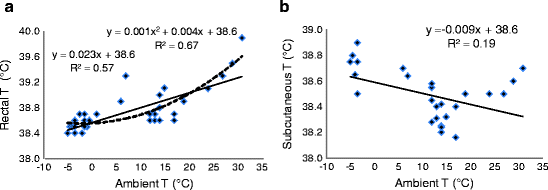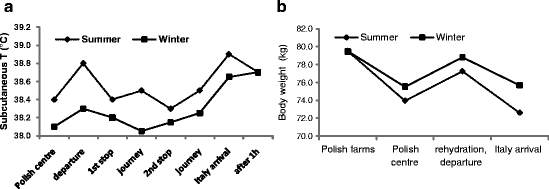Fig. 10.1
AT (left) (a) and truck temperature (right) (b) according to transport schedule

Fig. 10.2
Correlation between RT (left) (a) or ST (right) (b) and AT during the journey

Fig. 10.3
ST (left) (a) and BW (right) (b) according to transport schedule
Before departure, the calves showed a decrease in BW equal to 7.0% in July and 4.9% in January compared with values recorded at the Polish farm. After arrival in Italy, they showed a weight loss equal to 6.0% in July and 4.0% in January compared with before departure (Fig. 10.3b). During both seasons at the transit center after weighing, the calves were fed 5–6 L milk, increasing their BW by 4.4%. Therefore, the weight loss from the Polish farm to the Italian farm was equal to 8.7% (6.9 kg) in the summer and 4.8% (3.8 kg) in the winter. Afterward, a progressive increase in BW was seen within 24 h of arrival at the Italian farm. Seasonal effects had a significant influence on BW; likewise, transport effects were significant, showing a lower weight loss during the winter journey. ECGs revealed higher HR during loading and unloading, an increase of 31% and 26%, respectively, which are slightly higher than the normal range of 100–120 (Radostis et al. 2007). As the polarity of the deflections differed between calves, the P waves in DII were positive in some calves and negative in others. The mean electric axis varied from 60 to 180°.
10.4 Discussion
Twenty-hour road haulages, if carried out with suitable handling, personnel, and trucks, may lead to discomfort but not to stress because only the phases of alarm and adaptation, but not the phase of exhaustion of the GAS, should be expressed (Selye 1976). The wide range of AT during both transports activated adaptation in the calves that was controlled by efficient thermoregulation, assuring physiological homeothermia without the appearance of thermic stress. Within the tested thermic range, thermoregulation functioned properly, particularly in winter conditions. In summer, only AT near 30°C reduced the function of the thermoregulatory center with the concomitant appearance of clinical signs. Comparing summer and winter temperatures, a moderate linear correlation between AT and RT was observed, indicating that RT kept itself almost steady. The decrease in BW during the journeys could be due to fluid losses that were greater in the summer. In comparison with BW at the Polish farms, the weight loss recorded before departure could be ascribed to massive feeding given by the Polish farmers to achieve a greater sale price. Even though the calves did not show, during either transport, any clinical signs and only slight dehydration, it is important to prevent possible electrolyte and mineral losses by early supplementation during the first hours after arrival. Ethological anomalies, signals of psychophysical discomfort (stereotypes), were seen only at limited times without appearing obsessive and/or maniacal. During both transports, at the first stop, lying-down calves stood up within 3–4 min. During the journey, they exhibited cross-licking, cross-sucking, and self-grooming. After departure and for the whole length of the transport, the calves placed themselves with their cranial/caudal axis perpendicular to the driving direction. The animals showed discomfort during loading and unloading; furthermore, less psycho-physical discomfort was observed in the calves placed in the lower boxes of the truck compared with the upper ones. The changes found in the ECGs were critical during loading and unloading with sinusal tachycardia episodes. It is necessary to extend the data set of animals to better understand the causes of these HR increases. Individual animal sensitivities and subjective evaluation of the events make the animals vulnerable to the stress (Locatelli 1989), making it difficult to distinguish between discomfort and stress and to estimate the threshold values of stress. As the animal’s response is determined by complex interactions between genetic factors and experiences, it is impossible to generalize behaviors within the same or different breeds and species regarding various stressors. After the 20-h journey, the calves were not unloaded into the lairage cattle shed, but were transported for 2 additional hours to the destination farm. The handling of the animals during unloading and reloading in the lairage cattle shed causes not only further detrimental muscular strain but also an extension of the journey that leads to a marked change in homeostasis with a delayed return of biochemical blood parameters to normal (Bernardini et al. 2001). The stressors cannot be avoided, but as reported by Selye (1976), it is not necessary to completely remove the sources of stress, but instead to optimize them to make them tolerable and useful for survival and the execution of activities that the animals encounter. It is indispensable to execute a strategy that allows the farmers to work effectively within an international context and is characterized by increasing competition with new productive balances in light of national and community regulations.
Stay updated, free articles. Join our Telegram channel

Full access? Get Clinical Tree


